The Effect of Speed Humps on Instantaneous Traffic Emissions
Abstract
1. Introduction
2. Related Work
2.1. Traffic-Calming and Emissions
2.2. Cellular Automata and Traffic Flow
2.3. Emission Models
3. Traffic Flow and Instantaneous Emission Models
3.1. The Modified NaSch Model
- Acceleration If then increase the speed of the vehicle
- Deceleration If the speed hump is close enough then reduce the speed; if the vehicle is on the speed hump then reduce its velocity to its minimum. Otherwise the new velocity is given by the original deceleration rule of the NaSch model. For all cases also consider the distance to the front vehicle.
- Randomization Decrease the velocity of the vehicle with brake probability P
- Vehicle movement Update the position of the vehicle
3.2. Instantaneous Traffic Emission Model
4. Results and Discussion
4.1. The Impact of Speed Humps on Average Velocity and Traffic Flow
4.2. The Impact of Speed Humps on Instant Emissions
4.2.1. The Impact of Speed Humps on CO Emissions
- a few speed humps at roads with low density of vehicles generate more CO than roads with high densities (),
- a large number of speed humps at roads with low densities generates more CO than roads with low to middle densities ().
4.2.2. The Impact of Speed Humps on NO Emissions
4.2.3. The Impact of Speed Humps on VOC Emissions
- for a moderate number of speed humps, a road with a low number of vehicles generates more VOC emissions than a highly occupied road (),
- for a larger number of speed humps, a road with a high number of vehicles generates more VOC emissions than a low to middle density roads (),
- for a large number of speed humps, a road with a low number of vehicles () produces a similar quantity of VOC emissions than a road with a moderate number of vehicles ().
4.2.4. The Impact of Speed Humps on PM Emissions
5. Conclusions
- There are at least three phases for traffic flow and pollutants emissions as a function of density, these phases are in the range: for the first phase, for the second phase, and for the third phase.
- For low density of vehicles, the rise on CO, NO and PM emissions as we increase the number of speed humps on a lane provides evidence of the influence of speed humps on traffic emissions. We also found that slight variations on the position and distance between speed humps influence the generation of pollutants at low densities.
- For high density of vehicles, the impact of speed humps on average velocity and traffic flow may be ignored because most of the vehicles are not moving due to traffic jams.
Author Contributions
Funding
Acknowledgments
Conflicts of Interest
References
- Zhang, K.; Batterman, S.; Dion, F. Vehicle emissions in congestion: Comparison of work zone, rush hour and free-flow conditions. Atmos. Environ. 2011, 45, 1929–1939. [Google Scholar] [CrossRef]
- Zhang, K.; Batterman, S. Air pollution and health risks due to vehicle traffic. Sci. Total Environ. 2013, 450–451, 307–316. [Google Scholar] [CrossRef] [PubMed]
- Novi, C.D. The indirect effect of fine particulate matter on health through individuals’ life-style. J. Socio-Econ. 2013, 44, 27–36. [Google Scholar] [CrossRef]
- Deng, C.; Jin, Y.; Zhang, M.H.; Liu, X.; Yu, Z. Emission Characteristics of VOCs from On-Road Vehicles in an Urban Tunnel in Eastern China and Predictions for 2017–2026. Aerosol Air Qual. Res. 2018, 18, 3025–3034. [Google Scholar] [CrossRef]
- O’Driscoll, R.; ApSimon, H.M.; Oxley, T.; Molden, N.; Stettler, M.E.; Thiyagarajah, A. A Portable Emissions Measurement System (PEMS) study of NOx and primary NO2 emissions from Euro 6 diesel passenger cars and comparison with COPERT emission factors. Atmos. Environ. 2016, 145, 81–91. [Google Scholar] [CrossRef]
- Nyhan, M.; Sobolevsky, S.; Kang, C.; Robinson, P.; Corti, A.; Szell, M.; Streets, D.; Lu, Z.; Britter, R.; Barrett, S.R.; et al. Predicting vehicular emissions in high spatial resolution using pervasively measured transportation data and microscopic emissions model. Atmos. Environ. 2016, 140, 352–363. [Google Scholar] [CrossRef]
- Harrison, R.M.; Yin, J. Particulate matter in the atmosphere: Which particle properties are important for its effects on health? Sci. Total Environ. 2000, 249, 85–101. [Google Scholar] [CrossRef]
- Srimuruganandam, B.; Nagendra, S.M.S. Analysis and interpretation of particulate matter – PM10, PM2.5 and PM1 emissions from the heterogeneous traffic near an urban roadway. Atmos. Pollut. Res. 2010, 1, 184–194. [Google Scholar] [CrossRef]
- Baltrėnas, H.P.; Januševičius, T.; Chlebnikovas, A. Research into the impact of speed bumps on particulate matter air pollution. Measurement 2017, 100, 62–67. [Google Scholar] [CrossRef]
- Hagenbjörk, A.; Malmqvist, E.; Mattisson, K.; Sommar, N.J.; Modig, L. The spatial variation of O3, NO, NO2 and NOx and the relation between them in two Swedish cities. Environ. Monit. Assess. 2017, 189, 161. [Google Scholar] [CrossRef]
- Han, S.; Bian, H.; Feng, Y.; Liu, A.; Li, X.; Zeng, F.; Zhang, X. Analysis of the Relationship between O3, NO and NO2 in Tianjin, China. Aerosol Air Qual. Res. 2011, 11, 128–139. [Google Scholar] [CrossRef]
- Astarita, V.; Giofrè, V.P.; Guido, G.; Vitale, A. A Single Intersection Cooperative-Competitive Paradigm in Real Time Traffic Signal Settings Based on Floating Car Data. Energies 2019, 12, 409. [Google Scholar] [CrossRef]
- Iodice, P.; Senatore, A. Industrial and Urban Sources in Campania, Italy: The Air Pollution Emission Inventory. Energy Environ. 2015, 26, 1305–1317. [Google Scholar] [CrossRef]
- Taghizadeh-Alisaraei, A.; Abbaszadeh-Mayvan, A.; Hosseini, S.H. Bio-ethanol production from a mixture of rice hull and orange peel wastes. Biofuels 2019, 1–5. [Google Scholar] [CrossRef]
- de Morais, A.M.; de Morais Hanriot, S.; de Oliveira, A.; Justino, M.A.M.; Valente, O.S.; Sodré, J.R. An assessment of fuel consumption and emissions from a diesel power generator converted to operate with ethanol. Sustain. Energy Technol. Assess. 2019, 35, 291–297. [Google Scholar] [CrossRef]
- Park, E.; Lim, J.; Cho, Y. Understanding the Emergence and Social Acceptance of Electric Vehicles as Next-Generation Models for the Automobile Industry. Sustainability 2018, 10, 662. [Google Scholar] [CrossRef]
- Baltrėnas, P.; Vaitiekūnas, P.; Mincevič, I. Investigation on the impact of transport exhaust emissions on the air. J. Environ. Eng. Landsc. Manag. 2004, 12, 3–11. [Google Scholar] [CrossRef]
- Januševičius, T.; Grubliauskas, R. The effect of speed bumps and humps on the concentrations of CO, NO and NO2 in ambient air. Air Qual. Atmos. Health 2019, 12, 635–642. [Google Scholar] [CrossRef]
- Ghafghazi, G.; Hatzopoulou, M. Simulating the air quality impacts of traffic calming schemes in a dense urban neighborhood. Transp. Res. Part D Transp. Environ. 2015, 35, 11–22. [Google Scholar] [CrossRef]
- Daham, B.; Andrews, G.E.; Li, H.; Partridge, M.; Bell, M.C.; Tate, J. Quantifying the Effects of Traffic Calming on Emissions Using On-road Measurements. In Proceedings of the SAE 2005 World Congress & Exhibition. SAE International, Detroit, MI, USA, 11–14 April 2005. [Google Scholar] [CrossRef]
- Jateikienė, L.; Andriejauskas, T.; Lingytė, I.; Jasiūnienė, V. Impact Assessment of Speed Calming Measures on Road Safety. Transp. Res. Procedia 2016, 14, 4228–4236. [Google Scholar] [CrossRef]
- Gonzalo-Orden, H.; Rojo, M.; Pérez-Acebo, H.; Linares, A. Traffic Calming Measures and their Effect on the Variation of Speed. Transp. Res. Procedia 2016, 18, 349–356. [Google Scholar] [CrossRef]
- Lee, G.; Joo, S.; Oh, C.; Choi, K. An evaluation framework for traffic calming measures in residential areas. Transp. Res. Part D Transp. Environ. 2013, 25, 68–76. [Google Scholar] [CrossRef]
- Salau, T.A.O.; Adeyefa, A.O.; Oke, S.A. Vehicle speed control using road bumps. Transport 2004, 19, 130–136. [Google Scholar] [CrossRef]
- Rothman, L.; Macpherson, A.K.; Buliung, R.N.; Macarthur, C.W.P.; To, T.; Larsen, K.G.; Howard, A.W. Installation of Speed Humps and Pedestrian-Motor Vehicle Collisions in Toronto, Canada: A Quasi-Experimental Study; BMC Public Health: London, UK, 2015. [Google Scholar]
- Owen, B. Air quality impacts of speed-restriction zones for road traffic. Sci. Total Environ. 2005, 340, 13–22. [Google Scholar] [CrossRef]
- Sjödin, Å.; Persson, K.; Andréasson, K.; Arlander, B.; Galle, B.G. On-road emission factors derived from measurements in a traffic tunnel. Int. J. Veh. Des. 1998, 20, 147–158. [Google Scholar] [CrossRef]
- Pan, W.; Xue, Y.; He, H.D.; Lu, W.Z. Impacts of traffic congestion on fuel rate, dissipation and particle emission in a single lane based on Nasch Model. Physica A 2018, 503, 154–162. [Google Scholar] [CrossRef]
- Iodice, P.; Senatore, A. Evaluation of Dispersion Models for Predicting Carbon Monoxide Concentrations from Motor Vehicles in a Metropolitan Area. Int. Rev. Model. Simul. 2013, 6, 1928–1932. [Google Scholar]
- Fellendorf, M.; Vortisch, P. Integrated Modeling of Transport Demand, Route Choice, Traffic Flow and Traffic Emissions. In Proceedings of the Conference: 79th Annual Meeting of the Transportation Research Board, Washington, DC, USA, 9–13 January 2000. [Google Scholar]
- United States Environmental Protection. MOVES2014a User Guide; United States Environmental Protection: Washington, DC, USA, 2015.
- Barth, M.; Malcolm, C.; Younglove, T.; Hill, N. Recent Validation Efforts for a Comprehensive Modal Emissions Model. Transp. Res. Record 2001, 1750, 13–23. [Google Scholar] [CrossRef]
- Berkowicz, R. OSPM—A Parameterised Street Pollution Model. Environ. Monit. Assess. 2000, 65, 323–331. [Google Scholar] [CrossRef]
- AASHTO; Transportation Officials. Highway Safety Manual; AASHTO: Washington, DC, USA, 2010; Volume 1. [Google Scholar]
- Han, Y.S.; Ko, S.K. Analysis of a cellular automaton model for car traffic with a junction. Theor. Comput. Sci. 2012, 450, 54–67. [Google Scholar] [CrossRef]
- Rajeswaran, S.; Rajasekaran, S. Analysis of Single-Lane and Two-Lane Traffic Models by Using Cellular Automata. IJECCE 2012, 4, 1459–1464. [Google Scholar]
- Cui, N.; Chen, B.; Zhang, K.; Zhang, Y.; Liu, X.; Zhou, J. Effects of route guidance strategies on traffic emissions in intelligent transportation systems. Physica A 2019, 513, 32–44. [Google Scholar] [CrossRef]
- Ma, K.; Wang, H. Influence of Exclusive Lanes for Connected and Autonomous Vehicles on Freeway Traffic Flow. IEEE Access 2019, 7, 50168–50178. [Google Scholar] [CrossRef]
- Kerner, B.S. Three-phase traffic theory and highway capacity. Physica A 2004, 333, 379–440. [Google Scholar] [CrossRef]
- Nagel, K.; Schreckenberg, M. A cellular automaton model for freeway traffic. J. Phys. I France 1992, 2, 2221–2229. [Google Scholar] [CrossRef]
- Arai, K.; Sentinuwo, S.R. Spontaneous-braking and lane-changing effect on traffic congestion using cellular automata model applied to the two-lane traffic. Int. J. Adv. Comput. Sci. Appl. 2012, 3. [Google Scholar] [CrossRef][Green Version]
- Zeng, J.; Yu, S.; Qian, Y.; Feng, X. Expressway traffic flow model study based on different traffic rules. IEEE/CAA J. Autom. Sin. 2018, 5, 1099–1103. [Google Scholar] [CrossRef]
- Li, Q.L.; Wong, S.; Min, J.; Tian, S.; Wang, B.H. A cellular automata traffic flow model considering the heterogeneity of acceleration and delay probability. Physica A 2016, 456, 128–134. [Google Scholar] [CrossRef]
- Echab, H.; Lakouari, N.; Ez-Zahraouy, H.; Benyoussef, A. Phase diagram of a single lane roundabout. Phys. Lett. A 2016, 380, 992–997. [Google Scholar] [CrossRef]
- Lakouari, N.; Ez-Zahraouy, H.; Benyoussef, A. Traffic flow behavior at a single lane roundabout as compared to traffic circle. Phys. Lett. A 2014, 378, 3169–3176. [Google Scholar] [CrossRef]
- Lakouari, N.; Oubram, O.; Bassam, A.; Pomares Hernandez, S.E.; Marzoug, R.; Ez-Zahraouy, H. Modeling and simulation of CO2 emissions in roundabout intersection. J. Comput. Sci. 2020, 40. [Google Scholar] [CrossRef]
- Meng, J.; Zhang, J.F. The effect of deceleration strips upon traffic flow. Mod. Phys. Lett. B 2006, 20, 835–841. [Google Scholar] [CrossRef]
- Li, C.; Guo, H.; Zhang, Y.; Wang, W.; Jiang, X. Simulation for the Impacts of Speed Bumps on Traffic Flow Considering Driving Behaviors’ Diversity. In Proceedings of the CICTP 2016, Shangai, China, 6–9 July 2016. [Google Scholar] [CrossRef]
- Zhou, X.; Tanvir, S.; Lei, H.; Taylor, J.; Liu, B.; Rouphail, N.M.; Frey, H.C. Integrating a simplified emission estimation model and mesoscopic dynamic traffic simulator to efficiently evaluate emission impacts of traffic management strategies. Transp. Res. Part D Transp. Environ. 2015, 37, 123–136. [Google Scholar] [CrossRef]
- Joumard, R.; Jost, P.; Hickman, J.; Hassel, D. Hot passenger car emissions modelling as a function of instantaneous speed and acceleration. Sci. Total Environ. 1995, 169, 167–174. [Google Scholar] [CrossRef]
- Panis, L.I.; Broekx, S.; Liu, R. Modelling instantaneous traffic emission and the influence of traffic speed limits. Sci. Total Environ. 2006, 371, 270–285. [Google Scholar] [CrossRef] [PubMed]
- Lenaers, G. Dynamic On-Board Particulate Matter Mass Emissions Measurements. In Transports et pollution de l’air: 9e colloque; Joumard, R., Ed.; INRETS: Arcueli, France, 2000; Volume 2. [Google Scholar]
- Grigoratos, T.; Giorgio, M. Non-Exhaust Traffic Related Emissions. Brake and Tyre Wear PM; Publications Office of the European Union: Brussels, Belgium, 2014; pp. 1–53. [CrossRef]
- Woodward, H.; Stettler, M.; Pavlidis, D.; Aristodemou, E.; ApSimon, H.; Pain, C. A large eddy simulation of the dispersion of traffic emissions by moving vehicles at an intersection. Atmos. Environ. 2019, 215. [Google Scholar] [CrossRef]
- Wang, X.; Xue, Y.; Cen, B.L.; Zhang, P.; di He, H. Study on pollutant emissions of mixed traffic flow in cellular automaton. Physica A 2020, 537, 122686. [Google Scholar] [CrossRef]
- Schadschneider, A.; Chowdhury, D.; Nishinari, K. Chapter Seven–Vehicular Traffic II: The Nagel-Schreckenberg Model. In Stochastic Transport in Complex Systems; Schadschneider, A., Chowdhury, D., Nishinari, K., Eds.; Elsevier: Amsterdam, The Netherlands, 2011; pp. 243–279. [Google Scholar]
- Bento, A.; Roth, K.; Zou, Y. Vehicle Lifetime Trends and Scrappage Behavior in the U.S. Used Car Market; Technical report; Sol Price School of Public Policy and Department of Economics: Los Angeles, CA, USA, 2016. [Google Scholar]
- Timothy Beirnes, J. Analysis of Fleet Replacement Lifecycle; Technical report; South Florida Water Management District: West Palm Beach, FL, USA, 2012.
- Berkowicz, R.; Winther, M.; Ketzel, M. Traffic pollution modelling and emission data. Environ. Model. Softw. 2006, 21, 454–460. [Google Scholar] [CrossRef]
- Parry, T. Vehicle Licensing Statistics: Annual 2017 Revised; Technical report; Department for Transport: London, UK, 2018.
- Parry, T. Vehicle Licensing Statistics: Annual 2018; Technical report; Department for Transport: London, UK, 2019.
- Parry, T. Vehicle Licensing Statistics: 2019 Quarter 3 (Jul–Sep); Technical report; Department for Transport: London, UK, 2019.
- Parry, T. Vehicle Licensing Statistics: 2019 Quarter 1 (Jan–Mar); Technical report; Department for Transport: London, UK, 2019.



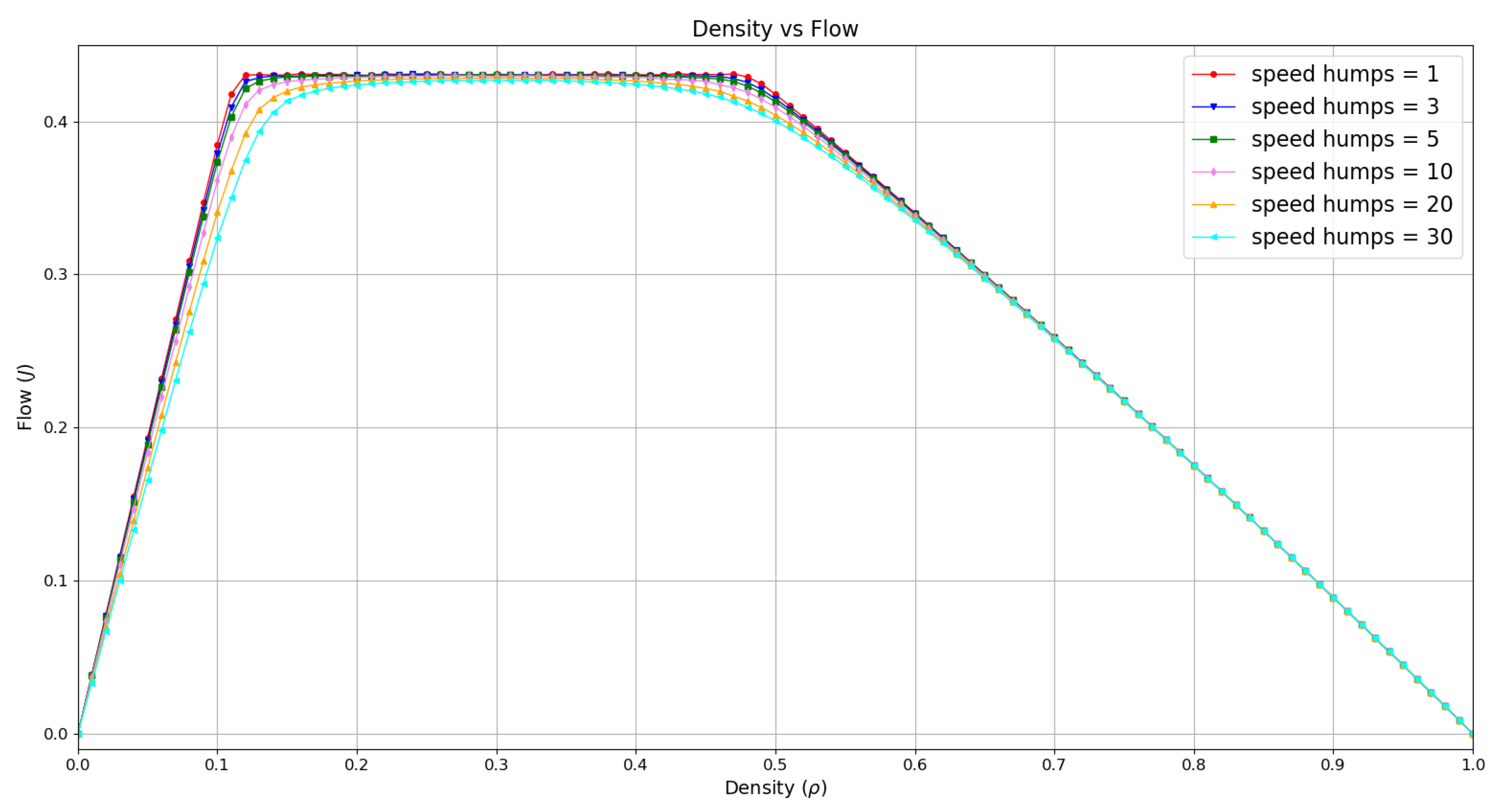
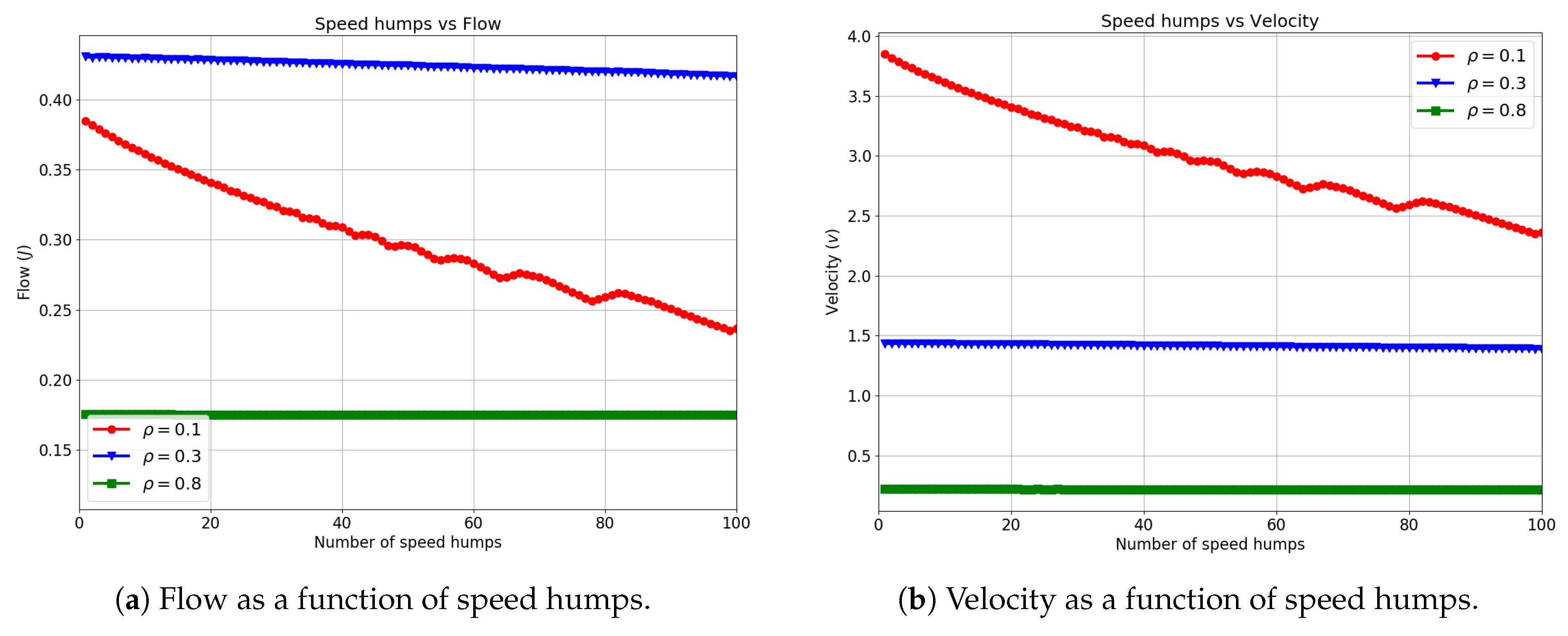

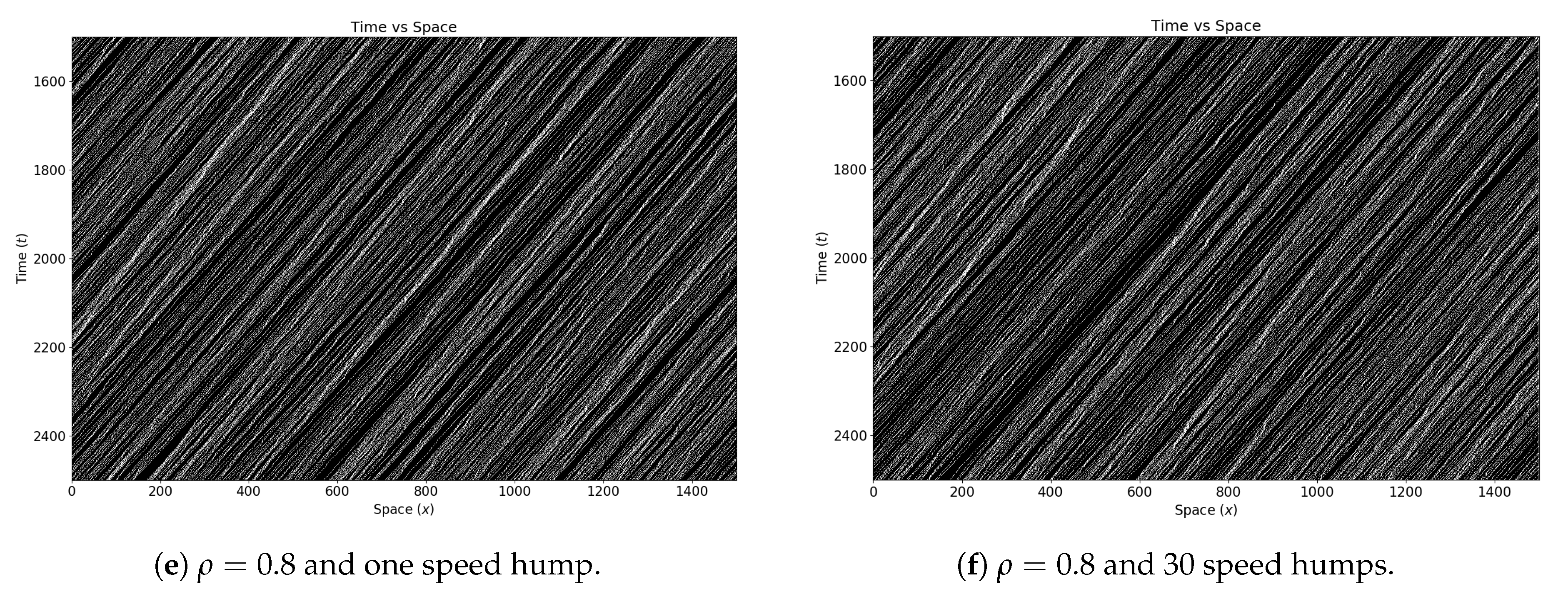
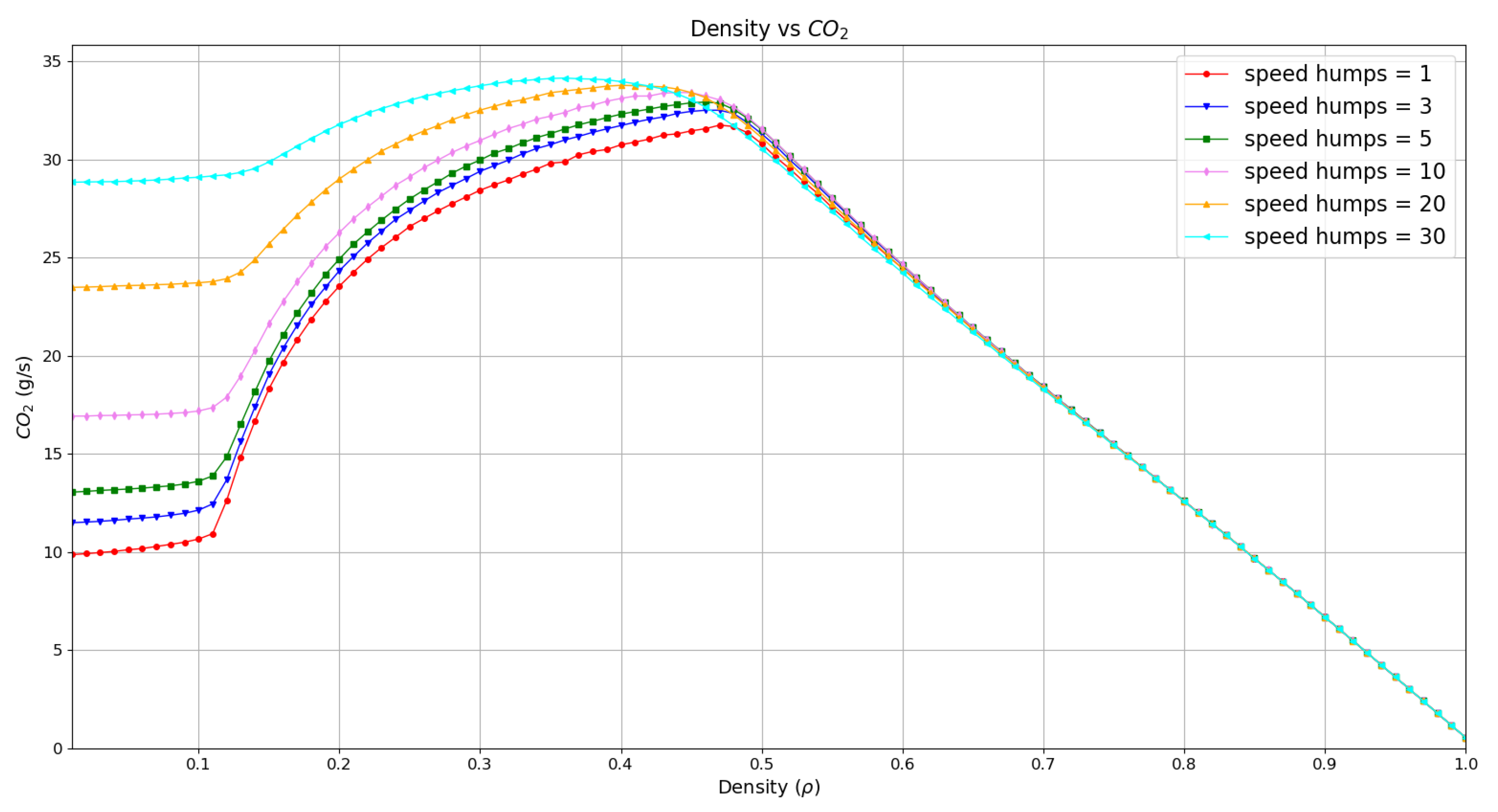
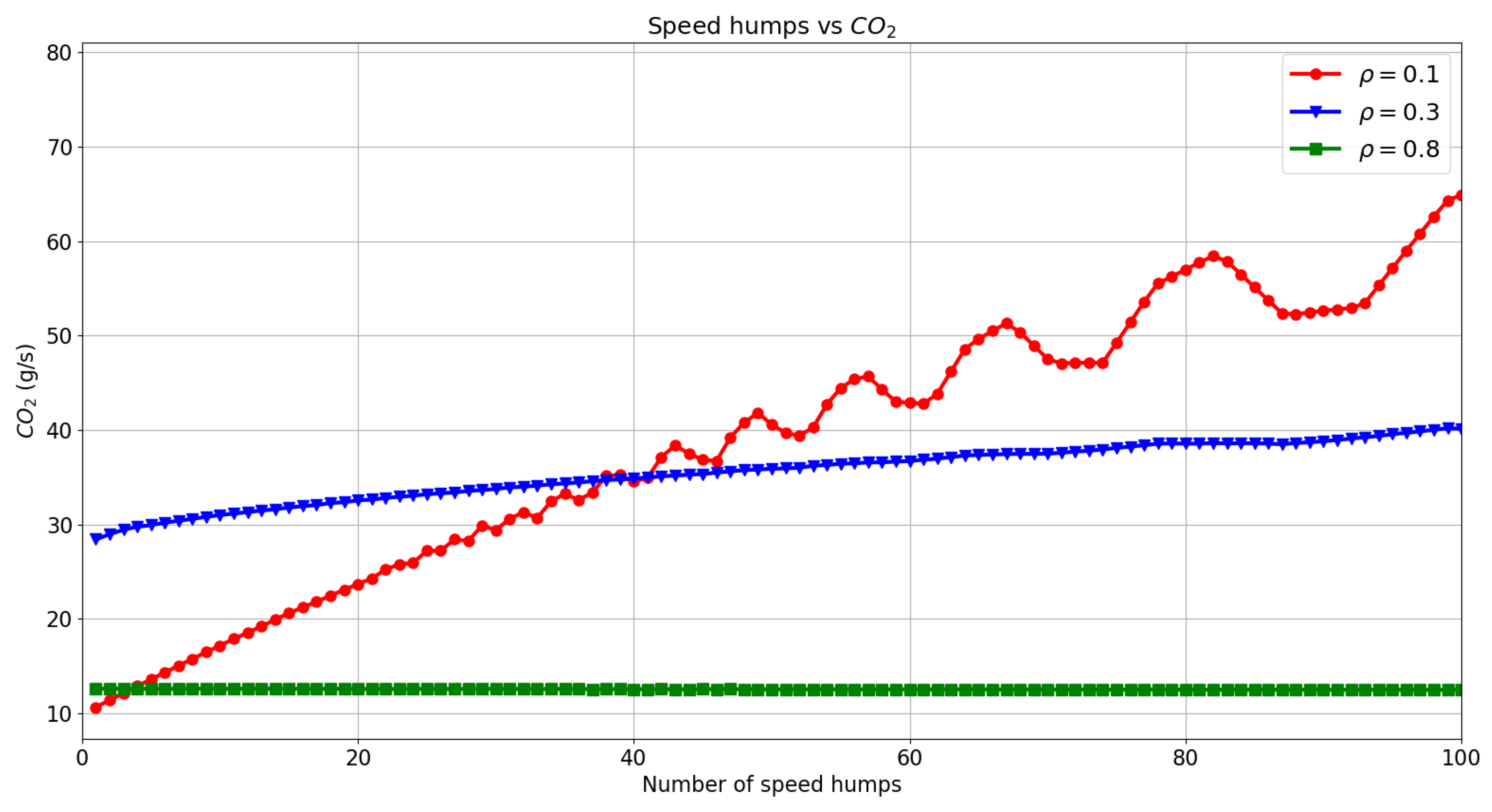
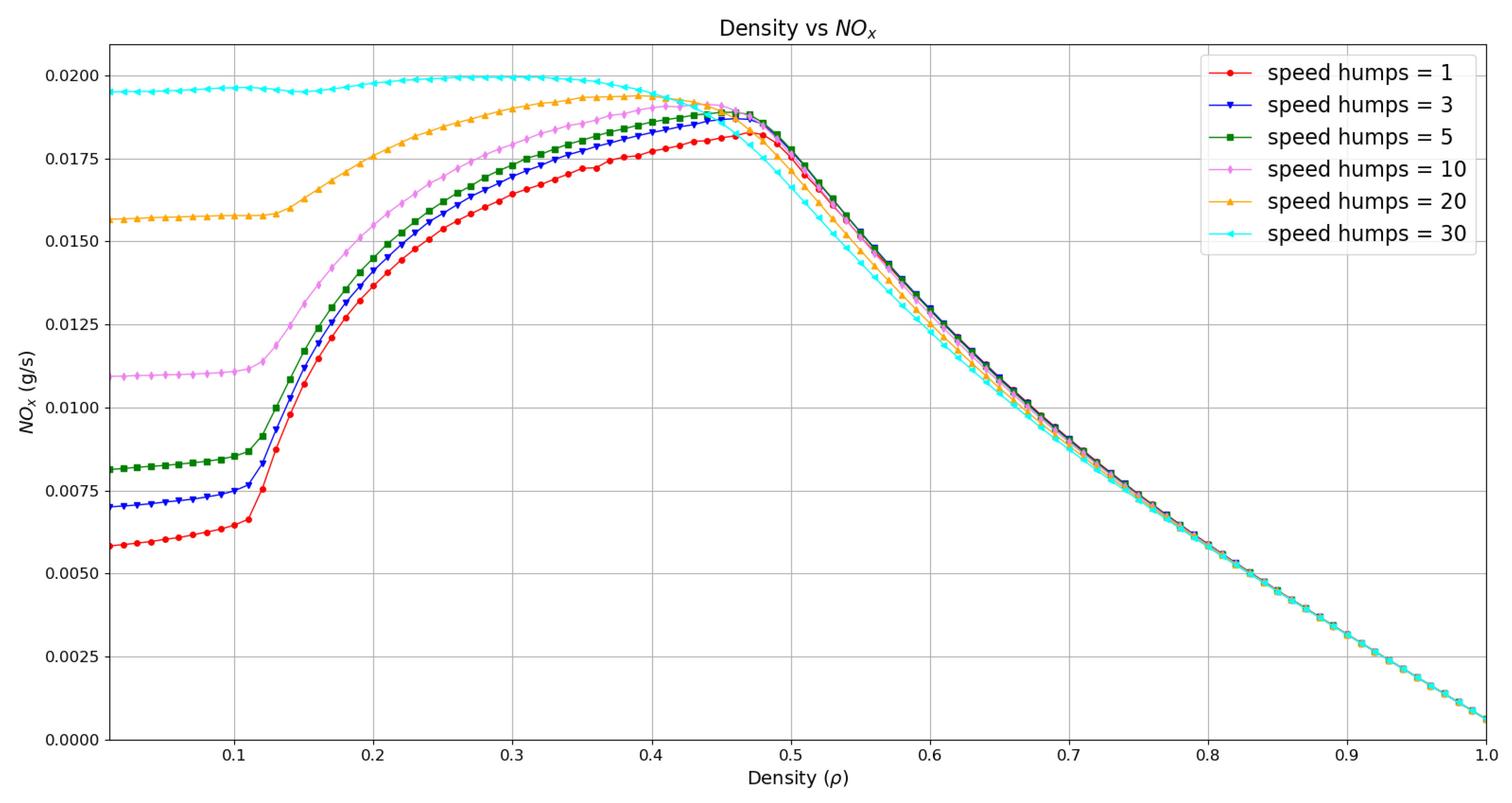
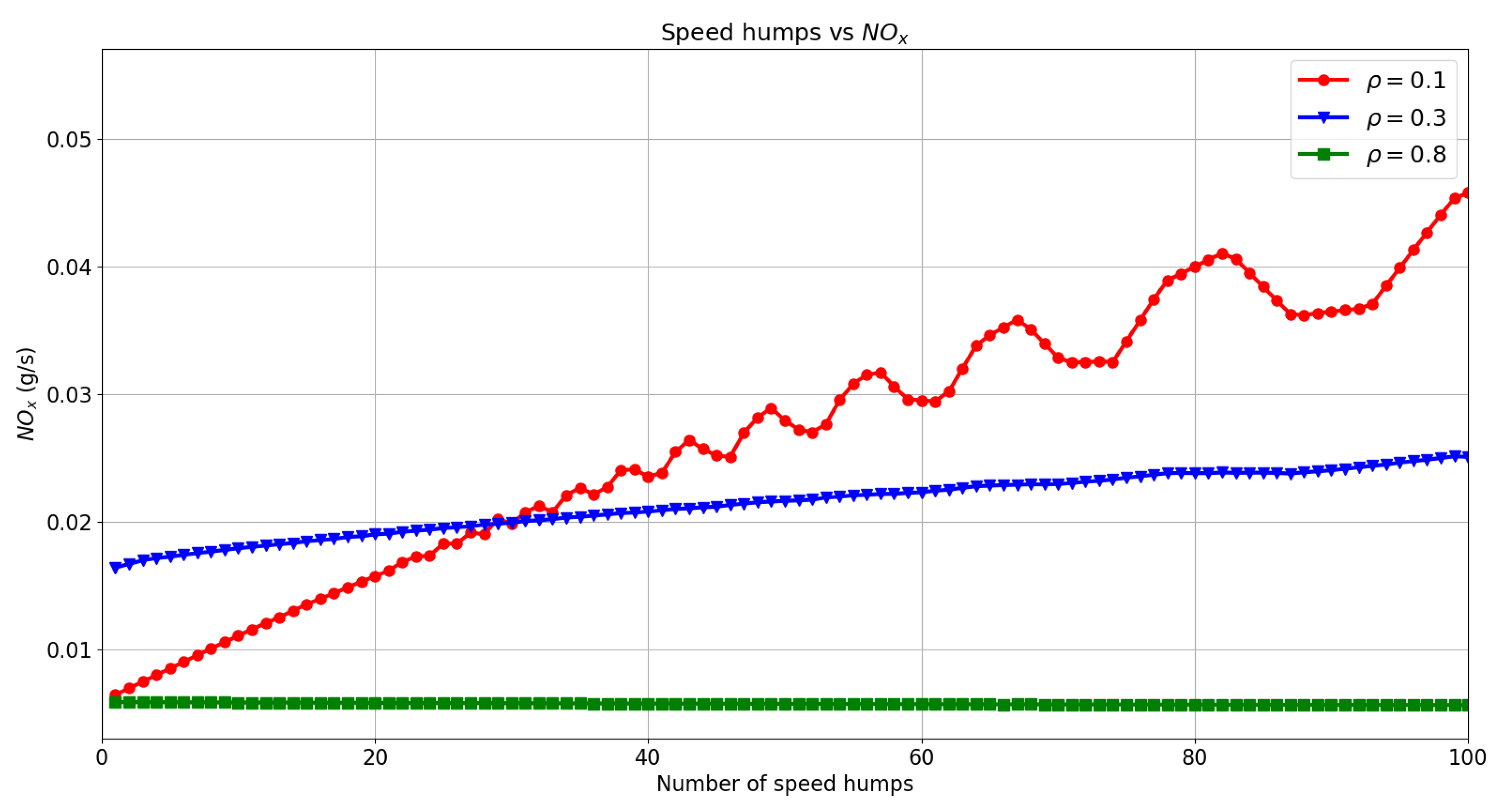
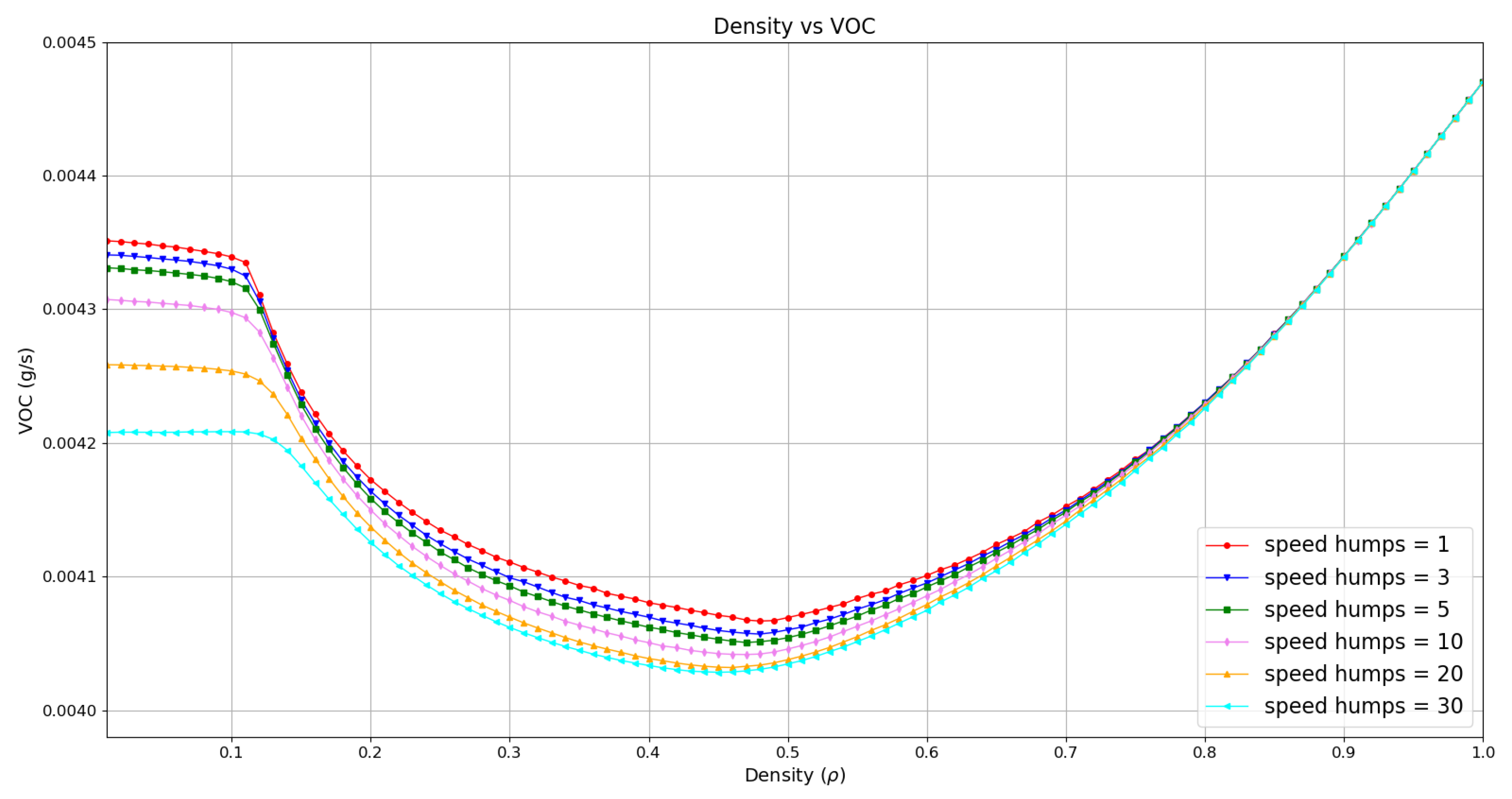

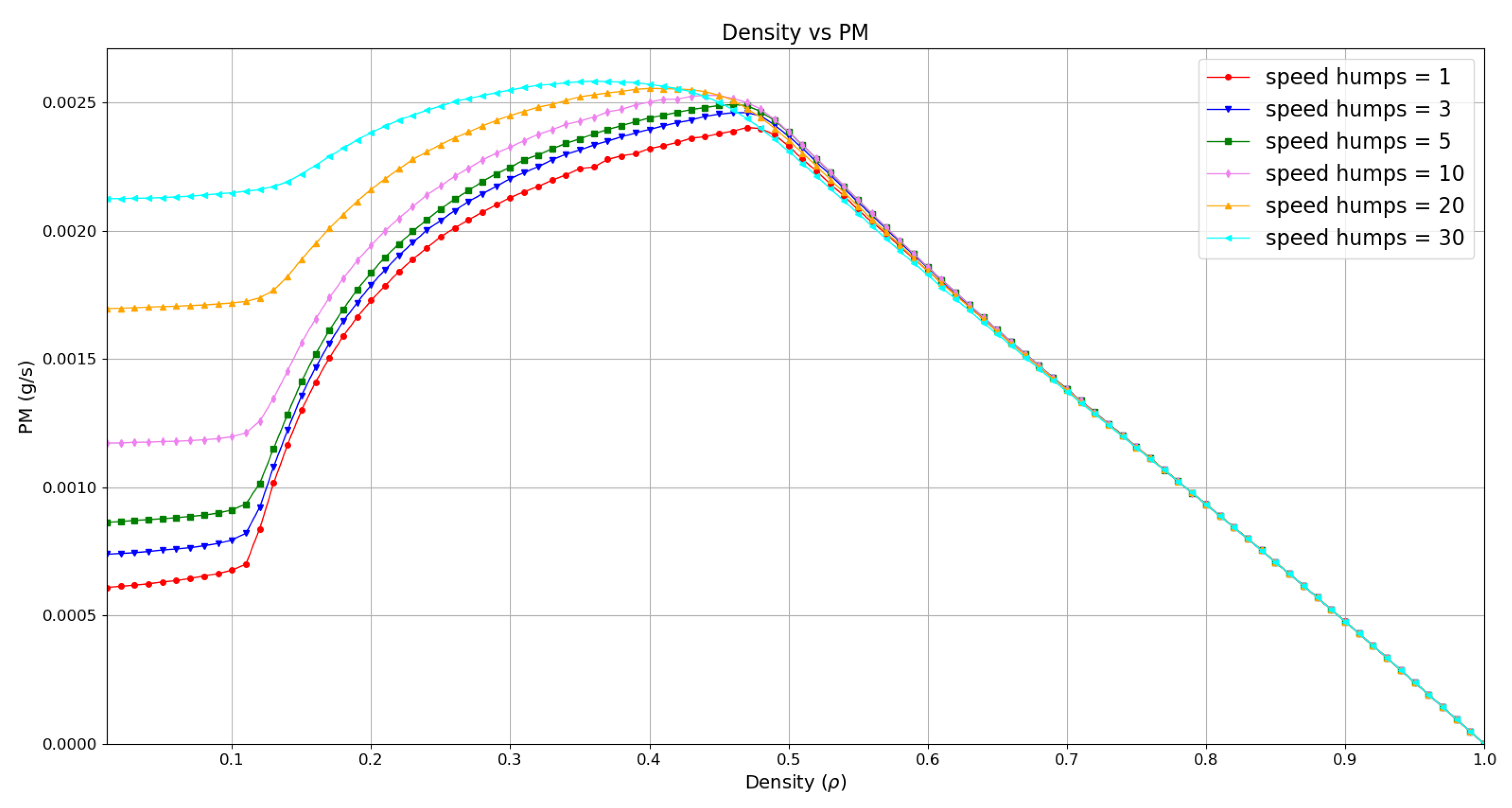
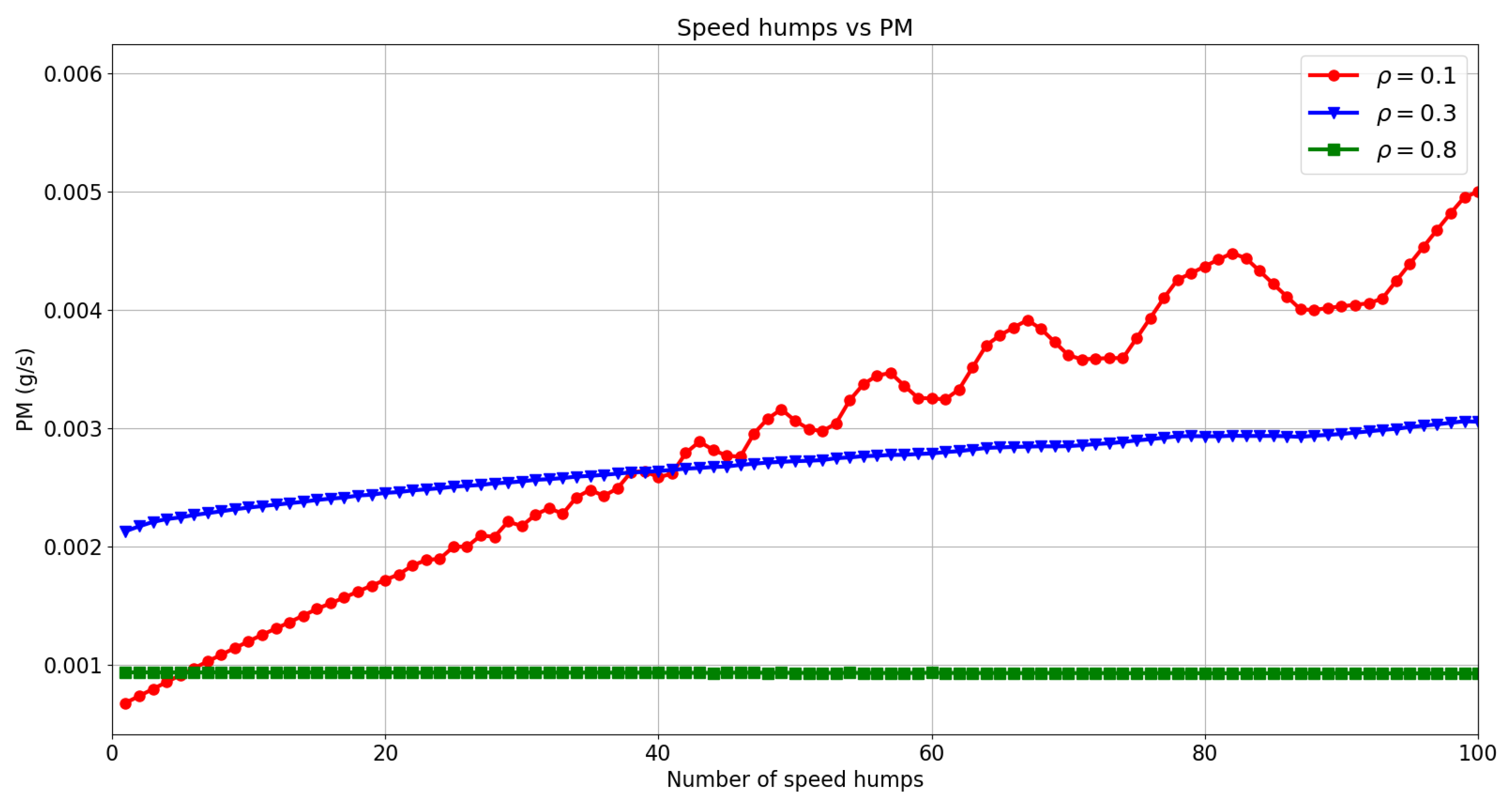
| Density | 3 sh | 61 sh | 66 sh | 71 sh |
|---|---|---|---|---|
| 0.1 | 0.590 | 1.227 | 1.261 | 1.216 |
| Pollutant | Vehicle Type | |||||||
|---|---|---|---|---|---|---|---|---|
| CO | Petrol car | 0 | 5.53 | 1.61 | −2.89 | 2.66 | 5.11 | 1.83 |
| NO | Petrol car ( m/s) | 0 | 6.19 | 8.00 | −4.03 | −4.13 | 3.80 | 1.77 |
| NO | Petrol car ( m/s) | 0 | 2.17 | 0 | 0 | 0 | 0 | 0 |
| VOC | Petrol car ( m/s) | 0 | 4.47 | 7.32 | −2.87 | −3.41 | 4.94 | 1.66 |
| VOC | Petrol car ( m/s) | 0 | 2.63 | 0 | 0 | 0 | 0 | 0 |
| PM | Petrol car | 0 | 0 | 1.57 | −9.21 | 0 | 3.75 | 1.89 |
© 2020 by the authors. Licensee MDPI, Basel, Switzerland. This article is an open access article distributed under the terms and conditions of the Creative Commons Attribution (CC BY) license (http://creativecommons.org/licenses/by/4.0/).
Share and Cite
Pérez-Sansalvador, J.C.; Lakouari, N.; Garcia-Diaz, J.; Hernández, S.E.P. The Effect of Speed Humps on Instantaneous Traffic Emissions. Appl. Sci. 2020, 10, 1592. https://doi.org/10.3390/app10051592
Pérez-Sansalvador JC, Lakouari N, Garcia-Diaz J, Hernández SEP. The Effect of Speed Humps on Instantaneous Traffic Emissions. Applied Sciences. 2020; 10(5):1592. https://doi.org/10.3390/app10051592
Chicago/Turabian StylePérez-Sansalvador, Julio César, Noureddine Lakouari, Jesus Garcia-Diaz, and Saúl E. Pomares Hernández. 2020. "The Effect of Speed Humps on Instantaneous Traffic Emissions" Applied Sciences 10, no. 5: 1592. https://doi.org/10.3390/app10051592
APA StylePérez-Sansalvador, J. C., Lakouari, N., Garcia-Diaz, J., & Hernández, S. E. P. (2020). The Effect of Speed Humps on Instantaneous Traffic Emissions. Applied Sciences, 10(5), 1592. https://doi.org/10.3390/app10051592








